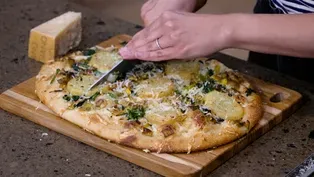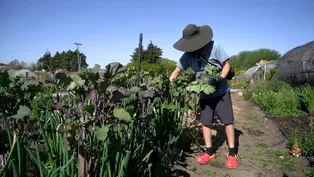
Leafy Greens - Harvesting Health
Clip: 9/27/2024 | 4m 11sVideo has Closed Captions
Our health expert explains how to get the most nutrition out of leafy greens like kale and collards.
Harvesting Health host Dr. Daphne Miller explains how to tenderize some of the tougher leafy greens, like kale and collards, to easily mix them into salad. Plus, see how adding lemon to leafy greens while cooking can bring out extra nutrients.
Problems with Closed Captions? Closed Captioning Feedback
Problems with Closed Captions? Closed Captioning Feedback
America's Heartland is presented by your local public television station.
Funding for America’s Heartland is provided by US Soy, Sustainable Agriculture Research and Education, Rural Development Partners, and a Specialty Crop Grant from the California Department of Food and Agriculture.

Leafy Greens - Harvesting Health
Clip: 9/27/2024 | 4m 11sVideo has Closed Captions
Harvesting Health host Dr. Daphne Miller explains how to tenderize some of the tougher leafy greens, like kale and collards, to easily mix them into salad. Plus, see how adding lemon to leafy greens while cooking can bring out extra nutrients.
Problems with Closed Captions? Closed Captioning Feedback
How to Watch America's Heartland
America's Heartland is available to stream on pbs.org and the free PBS App, available on iPhone, Apple TV, Android TV, Android smartphones, Amazon Fire TV, Amazon Fire Tablet, Roku, Samsung Smart TV, and Vizio.
Providing Support for PBS.org
Learn Moreabout PBS online sponsorship(soft rhythmic music) - Hi, folks.
Today we're at Urban Tilth Farm in Richmond, California.
And this place is near and dear to my heart.
It's about two miles from my medical clinic and we have a really interesting agreement with this farm where they are growing fruits and vegetables here, and cleaning them and harvesting them every week and packing them up in these paper bags.
And they're sent two miles down the road to our clinic where we, the doctors, get to hand them out as these food prescriptions, these produce prescriptions.
And we hand them out much like you would hand out a prescription for cholesterol medication or blood pressure medication.
And it's intended to do the same thing, which is protect our patients from heart disease and diabetes, and other types of diet related diseases.
These prescriptions are handed out each week in a medical group called the Healthy Eating Group, where we get together and we check blood pressure and check in on medications.
And then, we actually cook together.
And one of our favorite things to cook is something that comes from this farm almost every week.
This comes from a very special kind of tree.
It's a purple tree collared, which is a perennial plant, and you can harvest the leaves pretty much every week ongoing.
It produces new leaves.
And the seeds from this plant were thought to come originally from Africa.
And it's a plant that actually has been propagated and the seeds have been passed down by the African-American community.
One of the things we love to do in our group cooking is actually make salads from this purple tree collard.
And you might think, "Wow, this looks a little bit too tough to turn into a salad."
But the secret is to take a leaf and actually strip it off its stalk, and then what you can do is massage it.
And what that does is it breaks down the tough fibers and makes it so that it's much more like a typical lettuce in terms of eating it.
And then, you chop it up super fine as if you're making confetti for a parade.
And you toss it with your favorite salad dressing, and you can add in other fruits and vegetables.
Now it's not just tree collards or purple tree collards that you can massage in order to get this benefit of having them more tender.
You can do it with pretty much any kind of tough green.
This is a curly kale, which we also turn into salads.
And oftentimes, I'll make a mixture of both and throw them in with your more standard greens like your romaine or even some iceberg lettuce.
But the truth is that these greens have so much more nutrition in them.
They have more iron and more vitamin C and more fiber, and more antioxidants and beta-carotene.
So, it's actually a wonderful thing to have these in your salad.
It's great to add them to the mix both for taste and for that very agated color and for your health.
And when I cook kale, what I really try and do is cook it as lightly as possible.
You don't want it to get overcooked and kind of mushy.
You want it to have just that kind of a bright greenness to it.
And if you cook it with a little bit of citrus or a little bit of vinegar, that's gonna actually help release the nutrients in the kale and so that you're able to better absorb them in your body.
Thank you so much today for joining me at Urban Tilth, where we discovered how their food is literally being turned into medicine.
(soft piano music)
Broccoli Rabe Pizza - Farm to Fork
Video has Closed Captions
Learn how to make a homemade pizza with broccoli rabe, leeks and potatoes. (6m 3s)
Video has Closed Captions
Visit a farm that’s part of an innovative program called Food is Medicine. (5m 25s)
Providing Support for PBS.org
Learn Moreabout PBS online sponsorshipSupport for PBS provided by:
America's Heartland is presented by your local public television station.
Funding for America’s Heartland is provided by US Soy, Sustainable Agriculture Research and Education, Rural Development Partners, and a Specialty Crop Grant from the California Department of Food and Agriculture.














